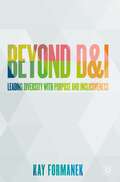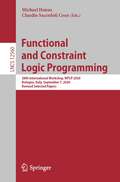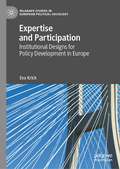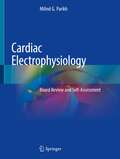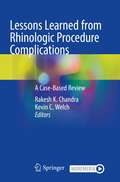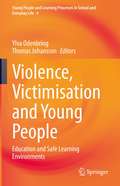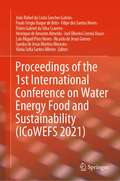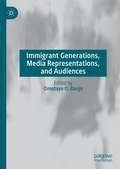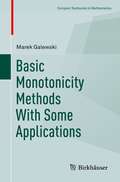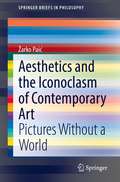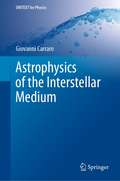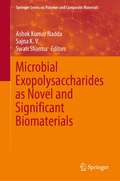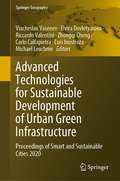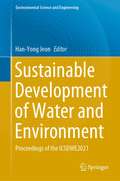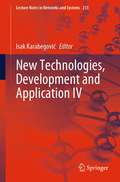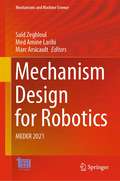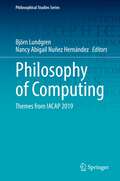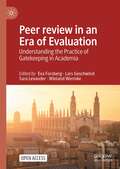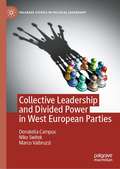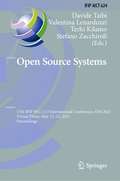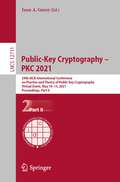- Table View
- List View
Beyond D&I: Leading Diversity with Purpose and Inclusiveness
by Kay FormanekD&I is no longer a passing fad. It’s not about legal compliance or HR box-ticking, in fact diversity and inclusion is a critical factor for success. #MeToo, #BlackLivesMatter and the ballooning disparate consequences of Covid-19 on minorities brings renewed emphasis on D&I agendas, and the economic reality that diverse talent is good for business and good for sustainability. In Beyond D&I, Kay Formanek brings her more than twenty years’ experience working with the world’s leading organizations to take diversity and inclusion into the strategic roadmap of the organization. Whether you’re a leader, HR practitioner, sponsor of a D&I initiative or an employee who wants to see your organization benefit from more inclusivity, the book equips you with the tools you need to develop the strategic case for diversity, craft a compelling narrative and chart a tailored roadmap to lock in diversity gains and close key performance gaps. As well as two core anchor models—the Virtuous Circle and Integrated Diversity Model— the book features case studies, profiles of inclusive leaders, engaging and intuitive visuals and a wealth of evidence-based initiatives that you can start implementing today. With five essential elements and six core capabilities, the result is a definitive, holistic and practical guide that will help you convert your D&I initiatives into sustainable diversity performance.
Functional and Constraint Logic Programming: 28th International Workshop, WFLP 2020, Bologna, Italy, September 7, 2020, Revised Selected Papers (Lecture Notes in Computer Science #12560)
by Michael Hanus Claudio Sacerdoti CoenThis book constitutes the refereed post-conference proceedings of the 28th International Workshop on Functional and Constraint Logic Programming, WFLP 2020, held in Bologna, Italy, in September 2020.Due to the COVID-19, the workshop was held online. From the 19 full papers submitted, 8 were accepted for presentation at the workshop. The accepted papers cover different programming areas of functional and logic programming, including code generation, verification, and debugging.
Expertise and Participation: Institutional Designs for Policy Development in Europe (Palgrave Studies in European Political Sociology)
by Eva KrickThis book deals with the role of expertise and public participation in modern governance. It explores the relationship, tensions and compatibility of these increasingly important and partly conflicting sources of legitimacy and authority. By zooming in on the coordinated procedures of environmental policy-making in European consensus systems and by interconnecting theories of democracy, knowledge and science, organisation and decision-making, the author develops institutional solutions to the tensions between epistemic and democratic demands on public policy-making.
Cardiac Electrophysiology: Board Review and Self-Assessment
by Milind G. ParikhThis book offers a comprehensive review of clinical cardiac electrophysiology in a question and answer format. Chapters contain over 200 questions divided into 9 chapters, each organized by cardiac electrophysiology topic. Each question is followed by the correct answer with a detailed explanation along with references for further reading. Important concepts are highlighted and supported by over 200 illustrations and high resolution images. The book addresses a broad range of topics that are important when studying for the initial certification or recertification of the clinical cardiac electrophysiology board examination. It is also highly relevant for daily clinical practice in cardiology and cardiac electrophysiology.Topics covered in the book include:Review of basic and clinical cardiac electrophysiology principles associated with cardiac arrhythmiasThe evaluation and management of patients with cardiac rhythm disordersReview of pharmacologic and nonpharmacologic therapies for the treatment of arrhythmiasClinical indications, fundamental principles and electrical characteristics of implantable cardiac electronic devices such as pacemakers and defibrillatorsClinical, electrocardiographic, and electrophysiologic characteristics of specific cardiac arrhythmia syndromes Cardiac Electrophysiology Board Review is a must-have resource for cardiology and cardiac electrophysiology trainees as well as attending physicians preparing for the certification or recertification examination. It may also be a useful guide for cardiologists, cardiac electrophysiologists and all clinicians who wish to further their understanding of heart rhythm disorders.
Lessons Learned from Rhinologic Procedure Complications: A Case-Based Review
by Rakesh K. Chandra Kevin C. WelchDespite meticulous attention to details and expert technique, complications resulting from rhinologic procedures can occur during one's professional career. This book discusses real-life complications and why these unfortunate events occur, as well as how best to manage the consequent issues. The text also provides thoughtful strategies to prevent such situations going forward. The book is organized as a series of case-based chapters, each illustrating a complication involving the orbit, the skull base, unexpected bleeding, poor healing, or those relating to intraoperative decision making, and how each was managed by the authors. Each chapter begins with bullet points highlighting key clinical pearls illustrated by that particular case. Written by leaders in the field with decades of experience in sino-nasal procedures, the analysis complements expert opinions with evidence-based published literature and shares experiences related to the most current techniques, devices, and instrumentation. Every otolaryngologist practicing rhinologic procedures will appreciate the candid nature of the discussion and will find enrichment in this shared wisdom. Lessons Learned from Rhinologic Procedure Complications: A Case-Based Review serves practitioners of general otolaryngology as well as resident trainees in this field, explaining how best to identify, diagnose, and resolve a complication during rhinology procedures.
Violence, Victimisation and Young People: Education and Safe Learning Environments (Young People and Learning Processes in School and Everyday Life #4)
by Thomas Johansson Ylva OdenbringThis edited collection focuses on different aspects of everyday violence, harassment and threats in schools. It presents a number of in-depth studies of everyday life in schools and uses examples and case studies from different countries to fuel a discussion on national differences and similarities. The book discusses a broad range of concepts, findings and issues, under the umbrella of three main themes: 1) Power relations, homosociality and violence; 2) Sexualized violence and schooling; and 3) Everyday racism, segregation and schooling. Specific topics include sexuality policing, bullying, sexting, homophobia, and online rape culture. The school is young people’s central workplace, and therefore of great importance to students’ general feeling of wellbeing, safety and security. However, there is no place where youth are at greater risk of being exposed to harassment and violations than at school and on their way to and from school. Threats are a relatively common experience among school students, but some aspects of these mundane and frequent harassments and violations are not taken seriously and are, therefore, not reported. Harassment and violations often have negative effects on youth and children, and increase their risks of such adverse outcomes as school dropout, drug use, and criminal behaviour. Contemporary research has shown that gender is of great importance to how students handle and report, or do not report, various violent situations. Studies have also revealed how the notions of masculinity and of being a victim can be conflicting identities and affect how students handle situations of threat, violence and harassment. The importance of gender is also particularly evident with regard to sexual harassment. Female students generally report greater exposure to sexual harassment than male students do.
Proceedings of the 1st International Conference on Water Energy Food and Sustainability (ICoWEFS 2021)
by João Rafael da Costa Sanches Galvão Paulo Sérgio Duque de Brito Filipe dos Santos Neves Flávio Gabriel da Silva Craveiro Henrique de Amorim Almeida Joel Oliveira Correia Vasco Luís Miguel Pires Neves Ricardo de Jesus Gomes Sandra de Jesus Martins Mourato Vânia Sofia Santos RibeiroThis book presents the proceedings of the 1st International Conference on Water Energy Food and Sustainability – ICoWEFS 2021, a major forum to foster innovation and exchange knowledge in the water-energy-food nexus, embracing the Sustainable Development Goals (SDGs) of the United Nations, bringing together leading academics, researchers and industrial experts. It contains the work of authors from 33 countries.
Immigrant Generations, Media Representations, and Audiences
by Omotayo O. BanjoThis anthology examines how immigrants and their US-born children use media to negotiate their American identity and how audiences engage with mediated narratives about the immigrant experience (cultural adjustments, language use, and the like). Where this work diverges from other collections and monographs is the area is its intentional focus on how both first- and second-generation Americans’ complex identities and hybrid cultures interact with mediated narratives in general, alongside the extent to which these narratives reflect their experience. In a three-part structure, the collection examines representations, “zooms in” to explore the reception of these narratives through autoethnographic essays, and concludes in a section of analysis and critique of specific media.
Basic Monotonicity Methods with Some Applications (Compact Textbooks in Mathematics)
by Marek GalewskiThis textbook introduces some basic tools from the theory of monotone operators together with some of their applications. Examples that work for ordinary differential equations are provided. The illustrating material is kept relatively simple, while at the same time offering inspiring applications to the reader. The material will appeal to graduate students in mathematics who want to learn some basics in the theory of monotone operators. Furthermore, it offers a smooth transition to studying more advanced topics pertaining to more refined applications by shifting to pseudomonotone operators, and next, to multivalued monotone operators.
Aesthetics and the Iconoclasm of Contemporary Art: Pictures Without a World (SpringerBriefs in Philosophy)
by Žarko PaićThe main themes and aims of this book are understanding aesthetics, contemporary art and the end of the avant-garde not from the traditional viewpoint of the metaphysics of the beautiful and the sublime but rather thru close connection to the techno-genesis of virtual worlds. This book tackles problems in contemporary art theory such as the body in space and time of digital technologies, along with other issues in visual studies and image science. Further intentions exhibit the fundamental reasons for the disappearance of the picture in the era of virtual reality starting from the notion of contemporary art as realized iconoclasm; art has no world for its "image". The author argues that the iconoclasm of contemporary art has severe consequences. This text appeals to philosophers of art and those interested in contemporary art theory.
Seismic Data Interpretation and Evaluation for Hydrocarbon Exploration and Production: A Practitioner’s Guide (Advances in Oil and Gas Exploration & Production)
by Niranjan C. NandaThis book is meant for geoscientists and engineers who are beginners, and introduces them to the field of seismic data interpretation and evaluation. The exquisite seismic illustrations and real case examples interspersed in the text help the readers appreciate the interpretation of seismic data in a simple way, and at the same time, emphasize the multidisciplinary, integrated practical approach to data evaluation. A concerted effort has been made for the readers to realize that mindless interpretation of seismic data using sophisticated software packages, without having a grasp on the elementary principles of geology and geophysics, and coupled with their over-reliance on workstations to provide solutions can have appalling results all too very often.
Science | Environment | Health: Towards a Science Pedagogy of Complex Living Systems (Contributions from Science Education Research #10)
by Albert Zeyer Regula Kyburz-GraberThis book provides a fascinating insight into the on-going process of self- reflection in the Science|Environment|Health (S|E|H) community. The basic vision of a new S|E|H pedagogy is to establish a transdisciplinary dialogue between the three educational fields of science education, environmental education, and health education. This approach finds growing interest among science educators. Since 2014, the ESERA special interest group S|E|H has united both experienced and junior researchers all over Europe in a burgeoning research community.This book presents a selection of results of these vibrant activities. Systems theory has turned out to be a stimulating theoretical framework for S|E|H. The limits of predictability in complex living systems result in structural uncertainty for decision-making, and they ask for emphasising and rethinking the role of pedagogical concepts like informed citizenship and scientific literacy. They challenge crude scientific determinism in environmental and health education, which all too often ends up with students’ eco- and health depression. Instead, S|E|H conceives coping with uncertainty in terms of an interplay between cognitive and affective factors. The horizon of the future remains always open. Hope must never die in a new S|E|H pedagogy.Chapter 3 is available open access under a Creative Commons Attribution 4.0 International License via link.springer.com.
Astrophysics of the Interstellar Medium (UNITEXT for Physics)
by Giovanni CarraroThis book is based on a series of lectures for an Astrophysics of the Interstellar Medium (ISM) master’s degree in Astrophysics and Cosmology at Padova University. From the cold molecular phase in which stars and planetary systems form, to the very hot coronal gas that surrounds galaxies and galaxy clusters, the ISM is everywhere. Studying its properties is vital for the exploration of virtually any field in astronomy and cosmology. These notes give the student a coherent and accurate mathematical and physical approach, with continuous references to the real ISM in galaxies. The book is divided into three parts. Part One introduces the equations of fluid dynamics for a system at rest and acoustic waves, and then explores the real ISM through the role of thermal conduction and viscosity, concluding with a discussion of shock waves and turbulence. In Part Two, the electromagnetic field is switched on and its role in modulating shock waves and contrasting gravity is studied. Part Three describes dust and its properties, followed by the main stellar sources of energy. The last two chapters respectively address the various components of the ISM and molecular clouds and star formation.
Microbial Exopolysaccharides as Novel and Significant Biomaterials (Springer Series on Polymer and Composite Materials)
by Swati Sharma Ashok Kumar Nadda Sajna K. V.This book examines the commercial role of various microbial polysaccharides and recent advances in their production. Offering an overview of the physiological role, biosynthetic pathways and regulatory mechanisms, it also explores the current challenges regarding bioprocessing for the production of polysaccharides.
Advanced Technologies for Sustainable Development of Urban Green Infrastructure: Proceedings of Smart and Sustainable Cities 2020 (Springer Geography)
by Riccardo Valentini Carlo Calfapietra Elvira Dovletyarova Viacheslav Vasenev Zhongqi Cheng Luis Inostroza Michael LeuchnerThis proceedings book focuses on advanced technologies to monitor and model urban soils, vegetation and climate, including internet of things, remote sensing, express and non-destructive techniques. The Smart and Sustainable Cities (SSC) conference is a regular event, organized each second year in RUDN University (Russia) and providing a multidisciplinary platform for scientists and practitioners in urban environmental monitoring, modeling, planning and management.
Forgiveness and Restorative Justice: Perspectives from Christian Theology
by Myra N. Blyth Matthew J. Mills Michael H. TaylorThe meaning of ‘forgiveness’ and its role within restorative justice are highly contested. This book offers analysis from practical and academic perspectives within Christian theology, against a rich canvas of related concepts, including victimhood, sin, love, and vulnerability. Critical friends of restorative justice, the authors argue that forgiveness – whether as journey or act, unilateral or mutual, conditional or unconditional – is necessary to achieving a fully restorative resolution to acts of harm. They also suggest that Christianity, with its meaning-giving metanarrative of restoration, and preference for communitarian approaches to justice, may have epistemic value for evaluating and even deepening the theory and practice of restorative justice.
Sustainable Development of Water and Environment: Proceedings of the ICSDWE2021 (Environmental Science and Engineering)
by Han-Yong JeonThis book addresses the improvement and dissemination of knowledge on methods, policies and technologies for increasing the sustainability of development by de-coupling growth from natural resources and replacing them with knowledge-based economy, taking into account its economic, environmental and social pillars, as well as methods for assessing and measuring sustainability of development, regarding water and environment. This book gathers scholar and experts in related fields. All attendees from a vast range of companies, universities and government institutions acquire advanced technical knowledge and are introduced to new fields through discussions that focus on their own specialties as well as a variety of interdisciplinary areas. The authors hope most of scholars can find what they really need in this book.
New Technologies, Development and Application IV (Lecture Notes in Networks and Systems #233)
by Isak KarabegovićThis book features papers focusing on the implementation of new and future technologies, which were presented at the International Conference on New Technologies, Development, and Application, held at the Academy of Science and Arts of Bosnia and Herzegovina in Sarajevo on June 24–26, 2021. It covers a wide range of future technologies and technical disciplines, including complex systems such as Industry 4.0; patents in industry 4.0; robotics; mechatronics systems; automation; manufacturing; cyber-physical and autonomous systems; sensors; networks; control, energy, renewable energy sources; automotive and biological systems; vehicular networking and connected vehicles; effectiveness and logistics systems; smart grids; nonlinear systems; power, social and economic systems; education; and IoT. The book New Technologies, Development and Application III is oriented toward Fourth Industrial Revolution “Industry 4.0, ”implementation which improves many aspects of human life in all segments and leads to changes in business paradigms and production models. Further, new business methods are emerging and transforming production systems, transport, delivery, and consumption, which need to be monitored and implemented by every company involved in the global market.
Mechanism Design for Robotics: MEDER 2021 (Mechanisms and Machine Science #103)
by Saïd Zeghloul Med Amine Laribi Marc ArsicaultThis book presents the proceedings of the 5th IFToMM Symposium on Mechanism Design for Robotics, MEDER 2021, held in Poitiers, France, 23–25 June 2021. It gathers contributions by researchers from several countries on all major areas of robotic research, development and innovation, as well as new applications and current trends. The topics covered include: theoretical and computational kinematics, mechanism design, experimental mechanics, mechanics of robots, control issues of mechanical systems, machine intelligence, innovative mechanisms and applications, linkages and manipulators, micro-mechanisms, dynamics of machinery and multi-body systems. Given its scope, the book offers a source of information and inspiration for researchers seeking to improve their work and gather new ideas for future developments.
Philosophy of Computing: Themes from IACAP 2019 (Philosophical Studies Series #143)
by Björn Lundgren Nancy Abigail Nuñez HernándezThis book features a unique selection of works presented at the 2019 annual international conference of the International Association for Computing and Philosophy (IACAP). Every contribution has been peer-reviewed, revised, and extended. The included chapters are thematically diverse; topics include epistemology, dynamic epistemic logic, topology, philosophy of science and computation, game theory and abductive inferences, automated reasoning and mathematical proofs, computer simulations, scientific modelling, applied ethics, pedagogy, human-robot interactions, and big data, algorithms, and artificial intelligence.The volume is a testament to the value of interdisciplinary approaches to the computational and informational turn. We live in a time of tremendous development, which requires rigorous reflection on the philosophical nature of these technologies and how they are changing the world. How can we understand these technologies? How do these technologies change our understanding of the world? And how do these technologies affect our place as humans in the world? These questions, and more, are addressed in this volume which is of interest to philosophers, engineers, and computer scientists alike.
Peer review in an Era of Evaluation: Understanding the Practice of Gatekeeping in Academia
by Lars Geschwind Wieland Wermke Eva Forsberg Sara LevanderThis open access volume explores peer review in the scientific community and academia. While peer review is as old as modern science itself, recent changes in the evaluation culture of higher education systems have increased the use of peer review, and its purposes, forms and functions have become more diversified. This book put together a comprehensive set of conceptual and empirical contributions on various peer review practices with relevance for the scientific community and higher education institutions worldwide. Consisting of three parts, the editors and contributors examine the history, problems and developments of peer review, as well as the specificities of various peer review practices. In doing so, this book gives an overview on and examine peer review , and asks how it can move forward.This is an open access book.
Advances in Service and Industrial Robotics: RAAD 2021 (Mechanisms and Machine Science #102)
by Saïd Zeghloul Med Amine Laribi Juan SandovalThis book presents the proceedings of the 30th International Conference on Robotics in Alpe-Adria-Danube Region, RAAD 2021, held in Poitiers, France, 21–23 June 2021. It gathers contributions by researchers from several countries on all major areas of robotic research, development and innovation, as well as new applications and current trends. The topics covered include: novel designs and applications of robotic systems, intelligent cooperating and service robots, advanced robot control, human-robot interfaces, robot vision systems, mobile robots, humanoid and walking robots, bio-inspired and swarm robotic systems, aerial, underwater and spatial robots, robots for ambient assisted living, medical robots and bionic prostheses, cognitive robots, cloud robotics, ethical and social issues in robotics, etc. Given its scope, the book offers a source of information and inspiration for researchers seeking to improve their work and gather new ideas for future developments.
Collective Leadership and Divided Power in West European Parties (Palgrave Studies in Political Leadership)
by Donatella Campus Niko Switek Marco ValbruzziPolitical science research, especially in recent times, has recognized the centrality of party and executive leaders and their individual characteristics. The attention has been mostly directed towards individual leadership. However, one-chief leadership is not the only existing model of party governance, and some recent developments seem to have put forms of collective leadership into the spotlight. Two parties that have recently achieved remarkable electoral results, the Italian Five Star Movement and the German Alliance 90/The Greens, can be considered examples of alternative models of leadership. This book calls for a deep and systematic analysis of cases of parties in which powers and responsibilities appear to be shared among different individuals rather than being concentrated in the hands of just one leader. Drawing on the literature of organization and management theory, the book fills a gap in the literature of political science by developing a theoretical framework that may provide researchers with the tools for proceeding with the analysis of cases of party collective leadership. To illustrate their approach, the authors have selected three cases – the German Greens, Alternative for Germany, and the Five Star Movement in Italy – that show significant variation across types of collective leadership. The outcome of the empirical analysis contributes to a better knowledge of the nature and functioning of party leadership as well as raises questions that could be further addressed in future research.
Open Source Systems: 17th IFIP WG 2.13 International Conference, OSS 2021, Virtual Event, May 12–13, 2021, Proceedings (IFIP Advances in Information and Communication Technology #624)
by Stefano Zacchiroli Valentina Lenarduzzi Davide Taibi Terhi KilamoThis book constitutes the refereed proceedings of the 17th IFIP WG 2.13 International Conference on Open Source Systems, OSS 2021, held virtually in May 2021.The 4 full papers and 3 short papers presented were carefully reviewed and selected from 23 submissions. The papers cover a wide range of topics in the field of free/libre open source software (FLOSS) and discuss theories, practices, experiences, and tools on development and applications of OSS systems, with a specific focus on two aspects:(a) the development of open source systems and the underlying technical, social, and economic issue, (b) the adoption of OSS solutions and the implications of such adoption both in the public and in the private sector.
Public-Key Cryptography – PKC 2021: 24th IACR International Conference on Practice and Theory of Public Key Cryptography, Virtual Event, May 10–13, 2021, Proceedings, Part II (Lecture Notes in Computer Science #12711)
by Juan A. GarayThe two-volume proceedings set LNCS 12710 and 12711 constitutes the proceedings of the 24th IACR International Conference on Practice and Theory of Public Key Cryptography, PKC 2021, which was held online during May 10-13, 2021. The conference was originally planned to take place in Edinburgh, UK, but had to change to an online format due to the COVID-19 pandemic.The 52 papers included in these proceedings were carefully reviewed and selected from 156 submissions. They focus on all aspects of public-key cryptography, covering theory, implementations and applications. This year, post-quantum cryptography, PQC constructions and cryptanalysis received special attention.
